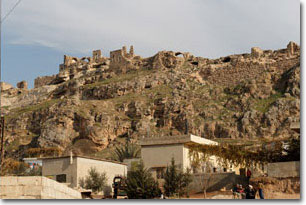|
 28 km
north east of Hama; it is located at a vital crossing point on the
Orontes. The settlement has classical origins, local legends recorded
by Diodorus Siculus (first century BC) claiming its foundation by a
regiment of Thessalonians cavalry from Alexander's forces. 28 km
north east of Hama; it is located at a vital crossing point on the
Orontes. The settlement has classical origins, local legends recorded
by Diodorus Siculus (first century BC) claiming its foundation by a
regiment of Thessalonians cavalry from Alexander's forces.
In the early Arab period, a Fatimid castle stood on the site but was
seized by the Byzantines in their effort to reassert their control in
Syria against the Fatimids. As the Byzantines hold weakened, a local
clan seized Shaizar in 1081. By the time the Crusaders had installed
themselves briefly in Qalaat Madiq to the north, the clansmen used
Shaizar as a base to harass their presence. Shaizar grew in importance as a center of Arab resistance, so much so
that the Crusaders set up positions in the mountains on the opposite
side of the plain to observe and contain Shaizar. The Byzantines
attempted in 1134 and 1138 to take the castle but failed. Much of it
was destroyed in 1157 by the severe earthquake which affected the
greater part of Syria. The Crusaders tried to profit from the
decimation of the clan owners in the destruction by moving on Shaizar,
occupying the lower citadel. But by then Nūr al Din was active in
northern Syria. He expelled them, repaired the damage and installed his
own governor. In 1170 another earthquake did further damage. Saladin's incorporation
of northern Syria after 1174 brought it under his control. A new keep
was constructed under the Ayyūbids (1233). The  first Mongol invasion of
Syria in 1260 brought renewed destruction but Baybars (1260 - 77) who
did much to revive Syria after the Mongol wave has passed, garrisoned
it. first Mongol invasion of
Syria in 1260 brought renewed destruction but Baybars (1260 - 77) who
did much to revive Syria after the Mongol wave has passed, garrisoned
it. Sultan Baybars the Mameluke and his successor, Qalaun, were probably
responsible for the substantive rebuilding of a good deal of the castle
as seen today. The castle fell into disuse as a military post but came
to shelter the village inhabitants whose building activities helped
erode its fabric until they were moved out in recent decades. |


